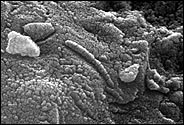It came from Mars
Four years ago, Hojatollah Vali was in the middle of a media storm, as a member of the team of scientists who announced to the world that they had found possible evidence of life on Mars.
That evidence had been found on the Martian meteorite known as ALH84001, which instantly became the most famous chunk of rock to land on our planet.
 ALH84001 up close
ALH84001 up close
| |
Since then, Vali, a professor in the departments of Earth and Planetary Sciences and Anatomy and Cell Biology, has found himself at the centre of scientific controversies surrounding ALH84001.
"Certain objections were raised to challenge our results," says Vali. "Some scientists said that, based on the mineral composition of the rock, it had to be formed at such a high temperature that no form of life could have existed on it." But Vali and his research associates published a 1997 article in Science demonstrating that the meteorite had never been heated beyond this point.
"We found magnetic particles on the meteorite; heating beyond a certain point would reorganize the orientation of these particles. Since we can measure their original orientation, we can prove that the rock was never heated above a certain temperature."
Another controversy concerned nanobacteria, fossils of bacteria on the rock which were so small that some scientists thought they could not have been the remains of living organisms.
"Nanobacteria are a theoretical concept. Many microbiologists argued that, because the proposed size of nanobacteria is below 200 nanometres, life cannot be supported because there is not enough space for DNA and RNA."
But after two years of studying cultured nanobacteria in the lab, Vali concluded that the nanofossils were not the remains of living organisms, "but they could have biogenic origin. I didn't find any fossilized bacteria that would give me the same structure that we found on the Martian meteorite. But I found protein-based mineralization which could give me those features.
"Our initial conclusion is that the forms found on the meteorite were created in association with protein. And, to our knowledge, there is no way to synthesize protein without microorganisms. So that's why I think there was some biogenic material involved in the type of mineralization we see on the meteorite." Biogenic activity is similar to life; it could refer to very basic microorganisms, simpler than bacteria and capable of some chemical reactions.
Currently, Vali is working to put out another fire; he is trying to explain the presence of glass formations within ALH84001.
"Usually, the conversion of mineral to glass would require thermal energy — heating to 1,200°, which would kill all life on the rock. But, as I mentioned, our magnetic data shows that the rock was never heated above 40° — and this conclusion is widely accepted. So I have to find a way to explain the formation of glass, maybe through pressure."
Vali remains cautious about the prospect of life on Mars, even at its most basic level.
"We have to be careful; what we have so far are indications and indirect evidence, not proof. So our work continues."

